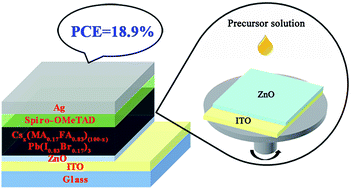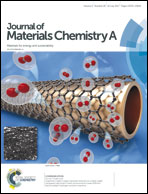Highly efficient and stable low-temperature processed ZnO solar cells with triple cation perovskite absorber†
Abstract
Although ZnO is a compatible electron transport layer (ETL) for perovskite solar cells (PSCs), the fact that MAPbI3 easily undergoes thermal decomposition on a low-temperature processed ZnO surface limits the use of one-step deposition of perovskite and hence the resulting photovoltaic performance. Herein, we demonstrate triple cation perovskite (Csx(MA0.17FA0.83)(100−x)Pb(I0.83Br0.17)3) prepared with a one-step deposition method as a stable light absorber in highly efficient PSCs with low-temperature processed ZnO as the ETL. The photovoltaic performance of the investigated PSCs was dependent on both the annealing temperature of the perovskite film and the composition of the Cs element in the perovskite structure. A remnant PbI2 passivation phase in the perovskite layer, in which the composition is Cs6(MA0.17FA0.83)94Pb(I0.83Br0.17)3 and the annealing temperature is 95 °C, leads to the highest power conversion efficiency of ∼18.9%, which is a record-high so far for low-temperature processed ZnO-based PSCs. Importantly, this PSC exhibits excellent environmental durability and photostability, which are critical characteristics for further commercialization of low-temperature processed PSCs.

- This article is part of the themed collection: Celebrating Excellence in Research: 100 Women of Chemistry


 Please wait while we load your content...
Please wait while we load your content...